Lifesaving Tips to Prevent a Carjacking and Not Become a Victim
Lifesaving Tips to Prevent a Carjacking and Not Become a Victim
I was browsing Facebook the other day and someone posted a link to the recent Colorado carjacking video. I clicked the link and was impressed with the video quality as I settled in to watch the events unfold. Before seeing the video, I’d seen bits and pieces on the nightly news and it looked like your typical criminal who really didn’t want to go back to jail. I knew one of the vehicles had a child in it which is always a terrible situation.
For the particular moments mentioned in this article, skip to 23:15, 48:20, 49:07 and 49:22.
As I watched the entire 54 minute video I began to internally critique the actions of the police and citizens involved. There were things done correctly but some things left me scratching my head. The big question I had was “why was it so easy for this criminal to carjack these vehicles?” For a descriptive timeline of events during this nearly hour long Colorado carjacking, read this article on 7NEWS / TheDenverChannel.com.
In this article, I’ll be talking about things you can do to prevent you or a loved one from being a victim in this type of situation. I’ll be drawing from my background conducting PSD missions and by “reverse engineering” the vehicle take downs I’ve done in law enforcement. We’ll also discuss ways to protect yourself from an armed carjacker, as there’s absolutely no reason you should ever be a victim of this type of unarmed carjacking.
Static vs. Rolling
The definition of static, in regards to vehicles, is being parked in a parking lot like a market, convenience store, or your driveway. Rolling refers to being “in transit on the roadway,” which includes stopping in traffic due to traffic control devices and traffic jams.
While the tips I’ll share will help for static situations, your vigilance will be the key to not being ambushed while getting in and out of your vehicle. Bryan wrote an excellent article on The Gift of Fear which I would highly recommend everyone read and practice.
Watch this video for a great example of what not to do when static:
- Where was the victims attention?
- Why didn’t he lock his doors (look up “gas station sliders“)
- Why in the world were his keys in the ignition?
- Never jump into the window and fight over the steering wheel. Your vehicle is not worth your life by being dragged.
- If you have a child or family in the vehicle then you should be armed in the first place and deal with the threat accordingly.
Carjacking vs. Ambush
I’d also like to differentiate between a criminal “carjacking of opportunity” and a deliberate planned attack, or ambush. The tactics of protecting yourself from an ambush are way beyond a criminal trying to run from the police with your car. For more on this, take a look at a previous article I wrote covering the Art of the Ambush.
While the video below is outside the scope of this article, it shows how quickly things can go to hell when you don’t have the mindset to use your vehicle to survive and the when the bad guy(s) have a plan. You can see the driver at the end of the video still in shock that the attack took place. He didn’t have the proper mindset at all.
Mindset
I’m going to break this up into “tactical” and “strategic” mindsets. There’s a big difference and hopefully my descriptions will make these clear to you.
Strategic Mindset
Having a strategic mindset when it comes to driving is all about forming habits. These are simple habits that will help you stay vigilant on the road and not become a victim of a criminal carjacking.
Next time you’re at a stoplight, take a good look at those around you. I’ll bet you a steak dinner that more than 3/4 of those people have their head down staring at their phone. Take a look at their posture, their vehicle and their passengers. Who could you carjack right then and there? Why? What did you see that would make you think jacking their vehicle would be easy? Now, think of you. How would you carjack you?
It’s important to develop a driving mindset that includes paying attention to things around you. Have habits like locking your doors if your vehicle doesn’t do it for you automatically. Get your head up and on a swivel (this also avoids crashes, go figure.) Being vigilant while driving will help you become much safer overall on the road. Lets face it, you’re more likely to be involved in a vehicle crash than to get carjacked.
The reality is that our phones are a huge distraction, but have become a necessary evil. I look at the Colorado video and wonder if the victims were distracted by their phones prior to being carjacked. I wonder how many people on the roadway that day were totally clueless as to what was going on around them. For those that watched the entire video above, you did see what was posted on the Amber Alert signs, right?
Tactical Mindset
Mindset is one of those buzz words most of our readers are familiar with. Things like “warrior mindset,” color coded posture labels, OODA (Observe, Orient, Decide and Act) Loops, and swiveling heads at the range come to mind. You can hardly read or watch anything related to training in the firearms industry without the instructor talking about mindset.
If you’re new to the firearms community, these things will still be sexy and hopefully a lightbulb is flickering to life. I feel mindset is the number one thing you should be concerned about. Having that gun on your hip will do you no good if you don’t have the mindset to use it.
This translates directly to driving and vehicles as well. I’m telling you right now to have the mindset that your vehicle can be used as a weapon and that you have to mentally rehearse running someone over, as scary as that may sound. Mentally rehearsing running a criminal down is no different than shooting at a realistic target at the range. Running someone over might be totally outside our normal thought process and will take up more decision time if you ever need to do it. This is why you need to have it ingrained into your thinking, otherwise you may freeze up. Here’s one example of police using vehicles during a deadly force situation:
If you’re at a deadly force level, you need to understand that your vehicle is a weapon, no different than a firearm. Conversely, you need to know this and not put yourself in a situation where your vehicle is being used against you in that manner. Think twice about jumping into the drivers window or an open drivers door!
Tactics: Good Guys vs. Bad Guys
Some of the tactics used by criminals are the same used by Law Enforcement. Lets face it, there are only so many ways to stop a vehicle while keeping it in one piece. However, a criminal mindset will be different than a non-criminal. Things like liability and personal safety aren’t necessarily in the mind of a criminal so they have more leeway when it comes the tactics they employ. Everything done in Law Enforcement takes safety and liability into consideration.
Since we’re talking about a carjacking and not an ambush (which is what Law Enforcement uses,) I won’t go into ambush tactics. As you saw in the Colorado video, the suspect did everything on the fly with the circumstances he was dealt. He didn’t set anyone up with pre-planning.
The Good Guys
Distance and Speed
One of the huge advantages you have as a driver is the ability to quickly gain distance from someone on foot. One disadvantage you have as a “good guy” is having to navigate obstacles like other vehicles and people. This is where mindset comes back into play and mentally rehearsing accelerating away from someone.
To gain your distance and then speed, you need to make sure you give yourself an “out” when slowed or stopped in traffic. I’m talking specifically about vehicle spacing. There are two things to consider when it comes to the distance you allow yourself when slowing and stopping. Specifically, do you close the distance to the vehicle in front of you or do you leave a gap?
- Closing distance to the vehicle in front of you is used in PSD style driving where you are in a convoy type situation. You don’t want to leave any space for another vehicle to pull between you and the vehicle in front of you. This works in a convoy, but I wouldn’t recommend it for single vehicle driving or even while traveling with another vehicle (like family or friends.)
- Leaving a gap is going to be the best bet in most cases. This is done by leaving enough distance from the rear bumper of the vehicle in front of you to be able to turn your wheels and drive around them. Typically, this is being able to see the rear tires of the vehicle in front of you. Pay attention to the other vehicles slowing or stopping around you as well. Look around and have an out.
Now that you’ve left enough space to drive out of a possible carjacking attempt, you need to be ready to rub some bumpers and fenders, or jump curbs and sidewalks. I don’t see a valid reason for anyone to run up to your vehicle and try to open your doors. In this day and age, a move like that should put a reasonable fear into anyone that some type of criminal activity is taking place. That being said, you may need to hit the cars around you to get out of that situation.
A quick tip on jumping curbs and sidewalks. You’ll want to make sure your vehicle has enough ground clearance so you don’t high-center it. I size up median dividers and curbs all the time. No matter what type of vehicle you drive you should always drive over curbs, dividers, parking blocks and sidewalks at an angle. This will allow you “slide” over them while keeping at least one drive wheel in contact with the ground at all times. It will also relieve the shock to the tires by not hitting the curb head on. You want to keep the momentum going and never stop on top as this is a torque maneuver, not a speed maneuver. Yes you can jump curbs and sidewalks at speed (at an angle,) but in the case of a carjacker on foot, torque is the key.
I’ve “jumped” so many curbs and medians at work that I have a good feel for what size/shape barriers I can get over. I don’t think your significant other will appreciate you practicing this with the family car, so a good way to see how this feels is to lay a 2×4 on the ground and drive over it. Try it head on and then at an angle, you will feel the difference.
Take a look at the video below and think about what you would do. The driver has no idea what this guy’s intent is and that he’s armed with something that can break the windows. What do you think the mindset of this driver is? Warning: Language
The Push Trough
There’s a technique commonly used in PSD driving called the “push through.” This is basically putting your front bumper on the back bumper of the vehicle in front of you and pushing it out of the way. This technique is successful when used by PSD drivers, as everyone has been trained in the technique and knows what and what not to do. The “pushing” driver knows not to totally slam into the front vehicle and the front vehicle driver knows to keep his foot off the brake. The torque of the pushing vehicle (not speed) makes this work.
Using this technique in a carjacking situation should be done with caution. You have no control over the vehicle in front of you and they might not release the brake for various reasons (like being pushed into traffic.) If you panic and slam into that vehicle, you may deploy your airbags, making your day even worse. Your best bet is to leave that distance to turn past the vehicle in front of you.
Good Guys Being Armed
Our unit just arrested a guy who tried to enter one of our U/C vehicles while attempting to get away on a warrant. He ran on foot from a patrol traffic stop and we were able to cut him off with our unmarked vehicles. Seeing that he was trapped, he attempted to open the front passenger door of one of our cars while a Detective was still in it. The Detective had the doors locked and instinctively drew a gun. Had the suspect entered the vehicle who knows what his intent would have been and how far he would have gone to escape. He would have had a bad day, that’s for sure.
Try to work vehicle scenarios into your concealed carry practice. It’s just as important to mentally rehearse what would happen at the mall with your family during an active shooter incident. Is it quicker to hit the gas or pull your gun? Do you have your family in the car with you and if so, how will that change your tactics? These are all things to consider before thinking that your gun is always the answer.
I don’t have any personal experience with ShivWorks (also known as SouthNarc,) but I’ve heard great things about their VCAST (Vehicle Combatives and Shooting Tactics) course. This type of training might be something to look into if you have the ability to attend.
The Bad Guys
What tactics will the criminals use against you? Your guess is as good as mine, but lets look at the Colorado carjacking and see why that guy was successful.
The first vehicle taken (with a boy inside) was from a gas station. It sounds like the mother left the doors unlocked and the keys in the ignition. How people do this is beyond me and I feel she should be held accountable, but I digress. In this case, it was more of a theft than a confrontational carjacking. Keeping your doors locked and not leaving the keys in the vehicle are the obvious answers here. For heaven’s sake, don’t leave your children unattended in the car!
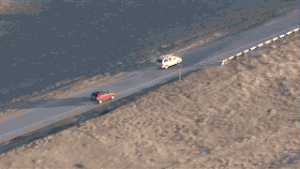 The second vehicle (van) is taken after the suspect cuts it off and forces it to a stop. I have to give credit where credit is due and say he did a great job of stopping the van. The issue arises when the driver of the van doesn’t have the doors locked. Had the doors been locked, the driver could have rubbed the bumper up front or put it in reverse and backed away. This driver was taken by complete surprise. No one wants to smash up their vehicle, but remember it’s just a tool.
The second vehicle (van) is taken after the suspect cuts it off and forces it to a stop. I have to give credit where credit is due and say he did a great job of stopping the van. The issue arises when the driver of the van doesn’t have the doors locked. Had the doors been locked, the driver could have rubbed the bumper up front or put it in reverse and backed away. This driver was taken by complete surprise. No one wants to smash up their vehicle, but remember it’s just a tool.
Since I have no first hand knowledge of the case, it’s hard to say whether or not the driver gave up the van out of fear. The suspect may have also implied he had a weapon. I would argue that having the doors locked and not seeing a firearm may have made a difference in this case. Remember you will have to weigh your options and a valid tactic may be to just give up your car if you’re caught totally off guard.
Avoiding being stopped in this manner means paying attention to what’s going on around you. You can see in the video that this stop happened quickly, so your OODA loop is going to be in overdrive. Mentally rehearsing these types of scenarios will help you in this type of situation. Do you drive around, push through, or reverse out?
After driving for some time it appears one of the suspect’s tires goes flat. He crashes into a white BMW waiting at a red light. You can see him jump out and look toward the BMW, but for whatever reason he decides to jump back in the van. Perhaps the BMW’s driver had a overt posture which the suspect did not want to deal with?
The suspect’s next attempt is a black 4-door which he rear ends. You can see his drivers door open ready for him to jump out. This would be a clue something is up when viewing this through your rearview mirror. Smartly the black car keeps rolling and doesn’t stop right away.
This was a smart move and a valid tactic if you’re ever involved in a crash. Nothing says you have to stay planted right where the “accident” occurred. If your spidey senses are tingling, go ahead and get some distance from the other vehicle to assess the situation. Keep your doors locked and windows up while dialing 911 to report the crash. I would suggest staying within a reasonable distance to the other driver so it doesn’t look like you’re trying to flee the scene. You don’t want to start a cat and mouse game over a legitimate accident.
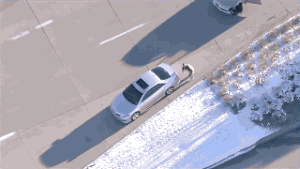 The suspect then continues down the road and side swipes a silver 4-door pretty hard. They continue a short distance and both vehicles stop. The suspect gets out and points to the damage to the van. He appears to stay fairly calm while approaching the silver car. The ruse works and he’s able to quickly open the unlocked driver door and eject the female driver.
The suspect then continues down the road and side swipes a silver 4-door pretty hard. They continue a short distance and both vehicles stop. The suspect gets out and points to the damage to the van. He appears to stay fairly calm while approaching the silver car. The ruse works and he’s able to quickly open the unlocked driver door and eject the female driver.
Again, if you’re involved in a crash, assess the situation. Don’t be so quick to pull over and jump out to assess the damage. There’s no doubt people become highly agitated over being involved in a crash, but there’s no reason to sacrifice your safety to appease someones sensibilities. If you’re with your family and you need to exit the vehicle, have your partner get into the drivers seat and be prepared to leave quickly. Have a phone ready to dial or re-dial 911 if the situation escalates.
Dealing With Armed Carjackers
As we saw while analyzing the Colorado video, there were simple measures the victims could have taken to prevent what happened. When it comes to armed criminals, there are no easy answers. Most likely it’s going to boil down to action vs. reaction. If someone gets the drop on you, you’re at a serious disadvantage. Sitting in a vehicle only compounds the problem. Do you hit the gas or draw your pistol? It all depends.
There are so many possible scenarios I can think of that it’s impossible to answer each one. What do you do alone, with your family, boxed in traffic, first in line at a red light, if the vehicle running or parked, are you armed, do you know where to aim when shooting through glass, do you have prior training? The list goes on and on.
This is where hands-on training will come into play. Mindset will get the gears spinning in the right direction, but you still need to physically practice things like drawing your pistol while seated with a seat-belt on. Both in the drivers and passenger seat.
Remember, avoidance is your best tactic when it comes to having to deal with an armed criminal.
Training
There are several companies out there teaching PSD style driving. If you have the resources to take such a class, definitely do it, but make sure to do some research and pick a legitimate company. Tony Scotti’s Vehicle Dynamics Institute (VDI) is one such company as is BSR. For the majority of us, those courses are probably not in the budget and in a case like the Colorado carjacking, it really isn’t necessary.
I would however strongly recommend participating in your local autocross to further your driving skills. The Sports Car Club of America and the National Auto Sport Association both put on local events all over the country. This is safe way to gain experience driving to the best of your abilities without breaking the bank.
The majority of the autocross courses are setup in large parking lots and designated with cones. The speeds are normally low for novice drivers and most courses are simple, yet technically challenging. This will build on your medium to low-speed vehicle handling which equals a better understanding of your vehicle during emergencies.
At the very least, find a remote location where you can practice gunning the gas from a low speed or a dead stop. I’ll go out on a limb and say most guys will have no problem with this, but what about your wife? Has she ever mashed the go pedal from a dead stop? Buy some small traffic cones from Lowe’s or Home Depot (they’re in the cleaning supply section) and set up a “vehicle” in front of you. You can drop in wooden dowels painted red to make them easier to see. Now practice gunning it around the cones in both directions from a dead stop. Set up a slalom course and run it forward and in reverse.
Everyone wants to learn the sexy stuff like J-Turns and Bootleg Turns. Sure they’re fun, but the reality is unless you practice these techniques, you’re more than likely going to crash or put yourself in a worse situation. These tactics are taught to defeat ambushes and not an unarmed carjacker like the Colorado suspect. If you can swing a class that teaches these maneuvers have fun, it’s a total blast and certainly has other real-world applications.
I would suggest training your family on commands you will use when there’s an imminent threat nearby. The first time your family hears “everyone get out!” shouldn’t be the first time things go south. You should come up with simple codes or phrases that everyone knows. If you have young children, never play around with this. Everyone needs to know you mean business. Treat this like a fire drill at home or when you’re out at the mall. Practice the steps you want everyone to take so they’ll react accordingly. I’ll be honest and admit our family needs to work on this. Sometimes it takes articles like this to dust off the training.
Vehicle Setup
There are a few things that you can do to help ensure you don’t fall victim to this type of carjacking. We spend a lot of time in our vehicles and we should think of them as tools. You should set up your vehicle no differently than setting up your Every Day Carry. While supplying your vehicle with things like medical or emergency gear can be expensive, these tips are pretty low to no-cost options.
Door Locks
The first and most obvious is locking your doors. While working with up-armored Suburbans in Bosnia we had specially modified door handles that would prevent someone from opening the doors from the outside, even if the doors were unlocked. Great if you can afford such a luxury, but that’s not reality for most of us.
As you see in the Colorado video, the suspect was able to simply open the doors and eject the drivers. If you have a vehicle that doesn’t lock the doors automatically when you put it in drive, you’ll need to develop the habit of doing it manually. Many aftermarket alarms will let you program the doors to automatically lock as well.
You may also be able to re-program your vehicle to do this by searching online for the factory programing sequence. This is usually done by performing a series of steps like turning the key to ACC, clipping the seatbelt in and out twice, waiting five seconds and turning the vehicle on. Look up your vehicle online and see what types of settings you can adjust yourself or see if the dealership can do it for you during your next service appointment.
Setting Your Mirrors
Secondly, you need to setup your mirrors properly. I would say the majority of drivers do not know how to adjust their mirrors correctly to avoid blind spots. This article from Car and Driver will help to explain the process of properly adjusting your mirrors. I would also suggest buying convex blind spot mirrors. They use double sided tape to secure to your outside mirrors and can be adjusted to see people approaching from the rear and sides. I rely heavily on these mirrors when conducting vehicle surveillance to detect people walking near my car.
Windows
Looking at the Colorado video, it’s hard to tell how much targeting the suspect did, if any. It’s my opinion that he simply used a target of opportunity, although all the victims appeared to all be female. Tinting your windows should be something to consider, as it makes it difficult to see how many occupants are inside. Heavily tinted windows are a headache in Law Enforcement and will also be a factor if your vehicle is being targeted by a criminal of opportunity.
Take a look at the vehicles around you the next time you’re sitting in traffic. Can you see through the tint? Do you know for sure how many people are inside? Is it a bunch of bearded meat eaters on the way to the range or a family oblivious to things around them?
Also be conscious when you have your windows rolled down. It’s great to get fresh air but you may want to consider rolling them up when you start slowing in traffic. In the Colorado video the suspect doesn’t have to worry about breaking windows because the doors were unlocked. Breaking a vehicle window is much harder than you may think, unless you have the proper (or big) tools seen in the crackhead video.
In Closing
Hopefully this article will get you thinking about carjacking prevention. It should also help you become a more observant driver which in turn will make you a safer driver. Have the mindset, have a plan, get the training and carry your gun!
Editor-in-Chief’s Note: This article contains tactics and techniques used by trained personnel. ITS Tactical assumes no responsibility for damages resulting from actions taken which were described in this article. Eric has a heavy background conducting PSD missions in the Army and now works as a Detective in a Tactical Surveillance Unit. This article is based on real world experience doing vehicle take downs utilizing unmarked vehicles.
Title photo © KUSA-TV






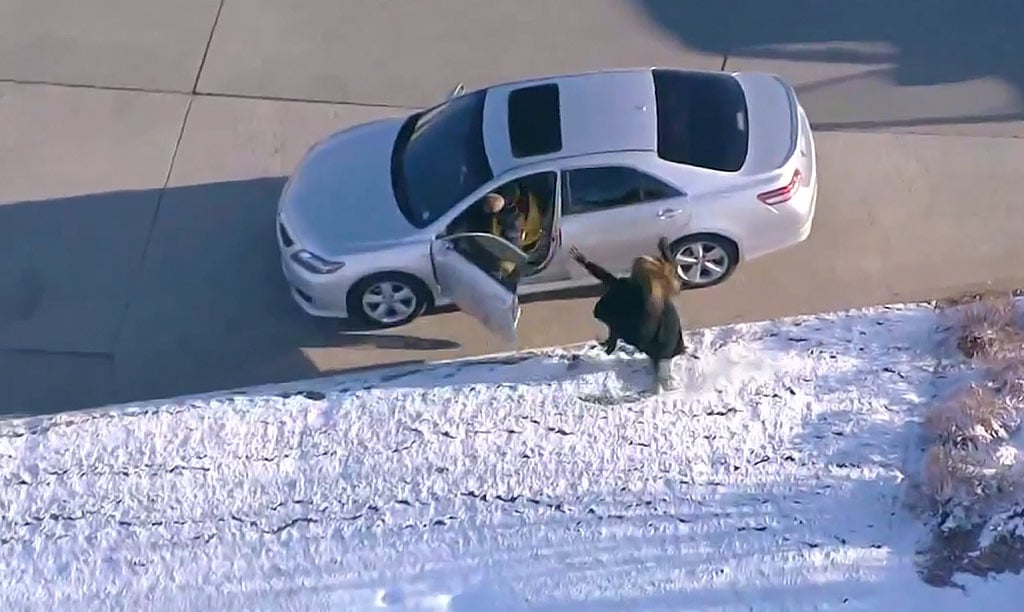

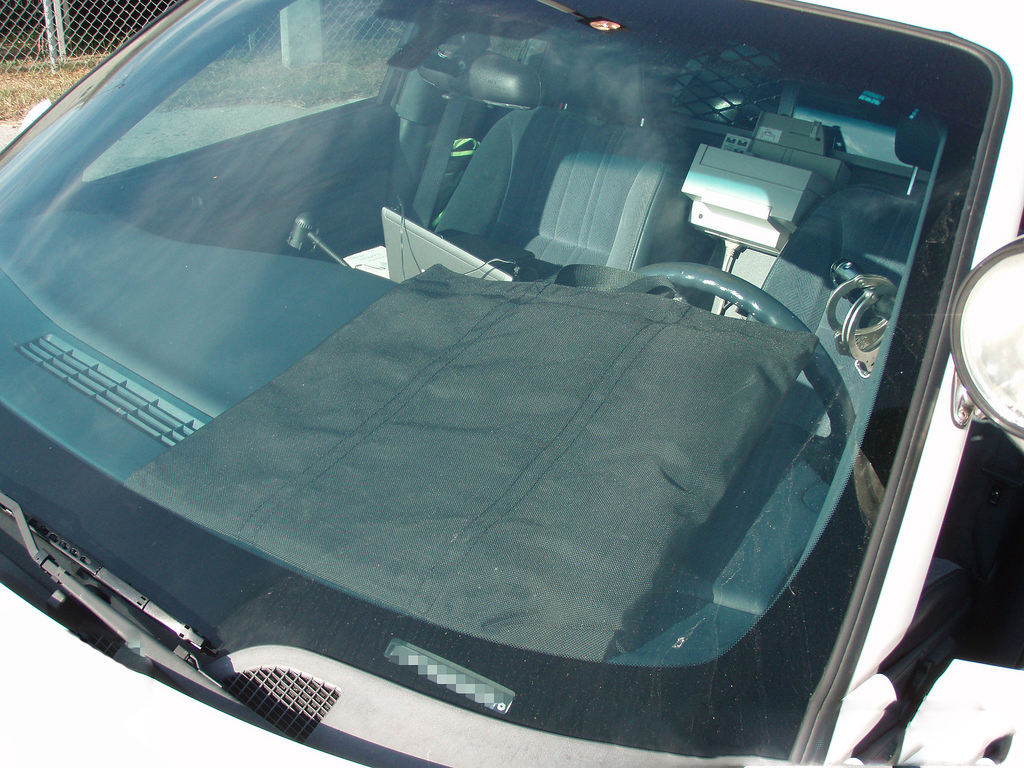
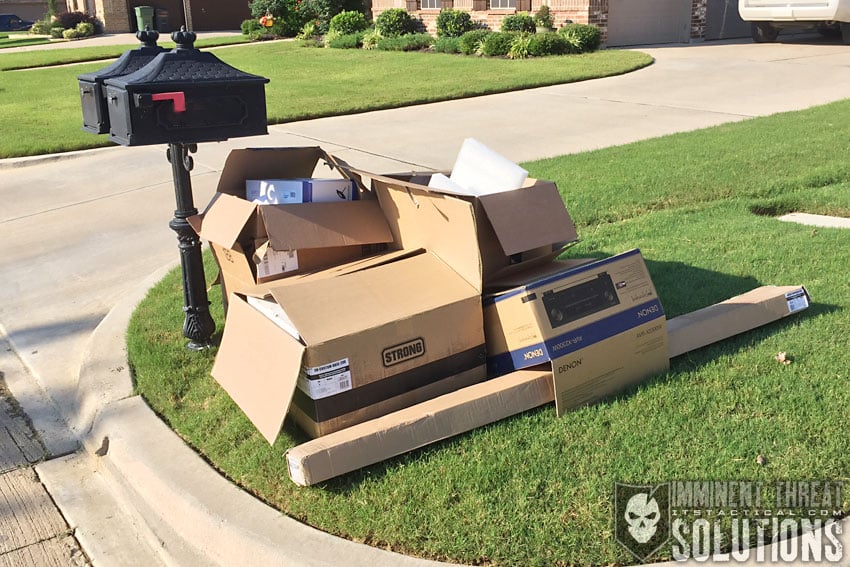


Discussion